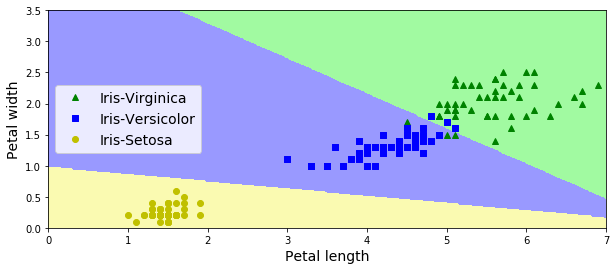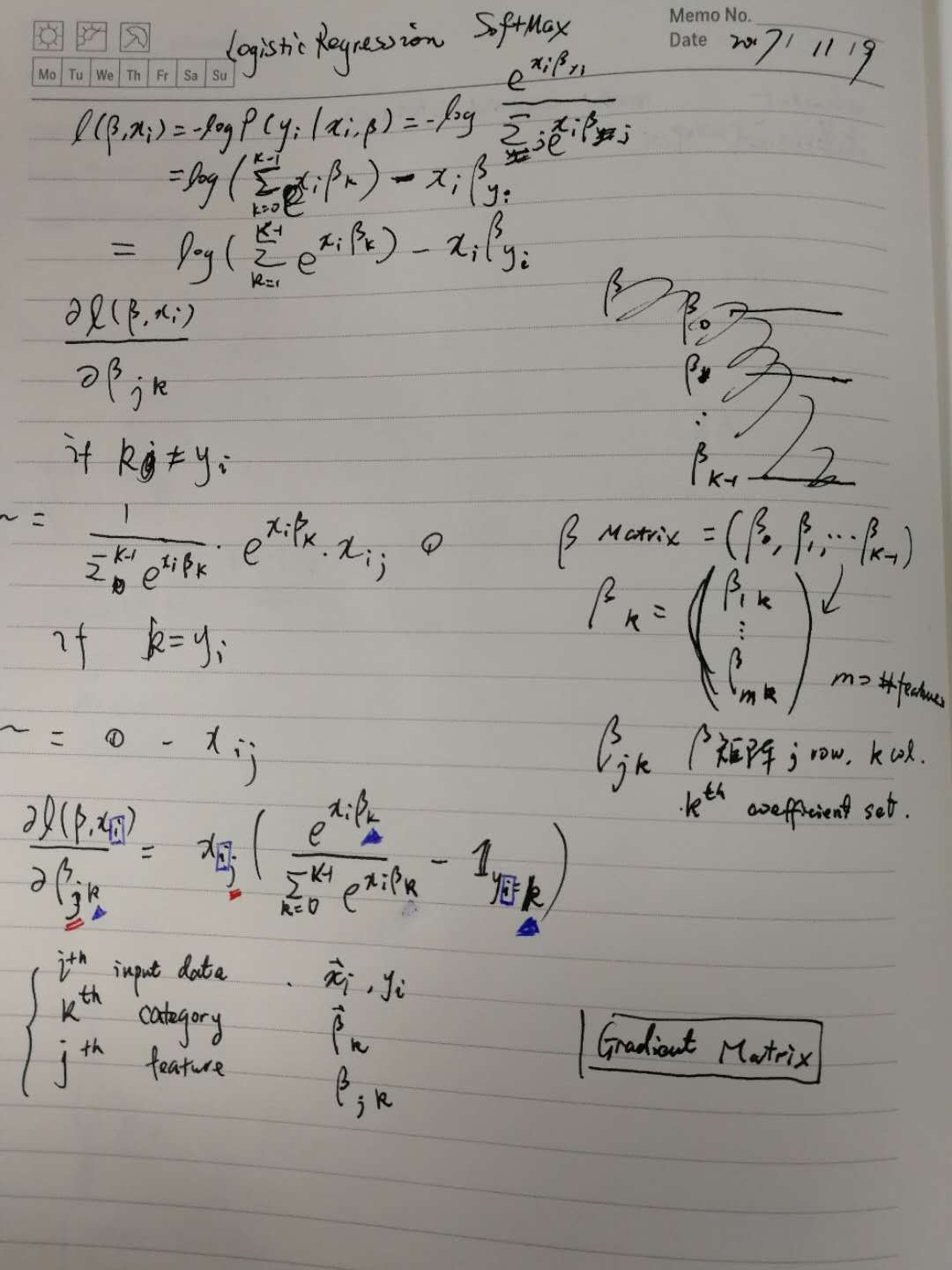LogisticRegression in MLLib
例子
iris数据训练Logistic模型。特征petal width和petal height,分类目标有三类。
import org.apache.spark.mllib.classification.LogisticRegressionWithLBFGS
import org.apache.spark.mllib.evaluation.MulticlassMetrics
import org.apache.spark.mllib.linalg.Vectors
import org.apache.spark.mllib.regression.LabeledPoint
import org.apache.spark.rdd.RDD
import org.apache.spark.sql.SparkSession
object Test1 extends App {
val spark = SparkSession
.builder
.appName("StructuredNetworkWordCountWindowed")
.master("local[3]")
.config("spark.sql.shuffle.partitions", 3)
.config("spark.sql.autoBroadcastJoinThreshold", 1)
.getOrCreate()
spark.sparkContext.setLogLevel("INFO")
val sc = spark.sparkContext
val data: RDD[LabeledPoint] = sc.textFile("iris.txt").map { line =>
val linesp = line.split("\\s+")
LabeledPoint(linesp(2).toInt, Vectors.dense(linesp(0).toDouble, linesp(1).toDouble))
}
// Split data into training (60%) and test (40%).
val splits = data.randomSplit(Array(0.6, 0.4), seed = 11L)
val training = splits(0).cache()
val test = splits(1)
// Run training algorithm to build the model
val model = new LogisticRegressionWithLBFGS()
.setIntercept(true)
.setNumClasses(3)
.run(training)
// Compute raw scores on the test set.
val predictionAndLabels = test.map { case LabeledPoint(label, features) =>
val prediction = model.predict(features)
(prediction, label)
}
// Get evaluation metrics.
val metrics = new MulticlassMetrics(predictionAndLabels)
val accuracy = metrics.accuracy
println(s"Accuracy = $accuracy")
}
训练结果
Accuracy = 0.9516129032258065
model : org.apache.spark.mllib.classification.LogisticRegressionModel: intercept = 0.0, numFeatures = 6, numClasses = 3, threshold = 0.5
weights = [10.806033250918638,59.0125055499883,-74.5967318848371,15.249528477342315,72.68333443959429,-119.02776352645247]
模型将特征空间划分结果(画图代码参见 http://www.cnblogs.com/luweiseu/p/7826679.html):

ML LogisticRegress算法
算法流程在:
org.apache.spark.ml.classification.LogisticRegression
protected[org.apache.spark] def train(dataset: Dataset[_],
handlePersistence: Boolean): LogisticRegressionModel
主要算法在:
val costFun = new LogisticCostFun(instances, numClasses, $(fitIntercept),
$(standardization), bcFeaturesStd, regParamL2, multinomial = isMultinomial,
$(aggregationDepth))
LogisticCostFun 实现了Breeze's DiffFunction[T]函数,计算multinomial (softmax) logistic loss
function, as used in multi-class classification (it is also used in binary logistic regression).
It returns the loss and gradient with L2 regularization at a particular point (coefficients).
该函数分布式计算参数梯度矩阵和损失
val logisticAggregator = {
// 每个训练数据instance参与计算梯度矩阵
val seqOp = (c: LogisticAggregator, instance: Instance) => c.add(instance)
// 各个partition的aggregator merge
val combOp = (c1: LogisticAggregator, c2: LogisticAggregator) => c1.merge(c2)
// spark聚合调用
instances.treeAggregate(
new LogisticAggregator(bcCoeffs, bcFeaturesStd, numClasses, fitIntercept,
multinomial)
)(seqOp, combOp, aggregationDepth)
}
Breeze凸优化:
LogisticCostFun 作为Breeze的凸优化模块(例如LBFGSB)的参数,计算最优的参数结果:
val states = optimizer.iterations(new CachedDiffFunction(costFun),
new BDV[Double](initialCoefWithInterceptMatrix.toArray))
LogisticCostFun 梯度计算(LogisticAggregator)
该模块包含了LogisticRegression训练多类分类器时迭代(online)的逻辑。
主要逻辑是给定一个训练样本\(x_i\),计算该样本对梯度矩阵中各个元素\(\beta_{j,k}\)的贡献。
LogisticAggregator computes the gradient and loss for binary or multinomial logistic (softmax)
loss function, as used in classification for instances in sparse or dense vector in an online
fashion.
Two LogisticAggregators can be merged together to have a summary of loss and gradient of
the corresponding joint dataset.
For improving the convergence rate during the optimization process and also to prevent against
features with very large variances exerting an overly large influence during model training,
packages like R's GLMNET perform the scaling to unit variance and remove the mean in order to
reduce the condition number. The model is then trained in this scaled space, but returns the
coefficients in the original scale. See page 9 in
http://cran.r-project.org/web/packages/glmnet/glmnet.pdf
However, we don't want to apply the [[org.apache.spark.ml.feature.StandardScaler]] on the
training dataset, and then cache the standardized dataset since it will create a lot of overhead.
As a result, we perform the scaling implicitly when we compute the objective function (though
we do not subtract the mean).
Note that there is a difference between multinomial (softmax) and binary loss. The binary case
uses one outcome class as a "pivot" and regresses the other class against the pivot. In the
multinomial case, the softmax loss function is used to model each class probability
independently. Using softmax loss produces K sets of coefficients, while using a pivot class
produces K - 1 sets of coefficients (a single coefficient vector in the binary case). In the
binary case, we can say that the coefficients are shared between the positive and negative
classes. When regularization is applied, multinomial (softmax) loss will produce a result
different from binary loss since the positive and negative don't share the coefficients while the
binary regression shares the coefficients between positive and negative.
The following is a mathematical derivation for the multinomial (softmax) loss.
The probability of the multinomial outcome \(y\) taking on any of the K possible outcomes is:
e^{\vec{x}_i^T \vec{\beta}_k}} \\
P(y_i=1|\vec{x}_i, \beta) = \frac{e^{\vec{x}_i^T \vec{\beta}_1}}{\sum_{k=0}^{K-1}
e^{\vec{x}_i^T \vec{\beta}_k}}\\
P(y_i=K-1|\vec{x}_i, \beta) = \frac{e^{\vec{x}_i^T \vec{\beta}_{K-1}}\,}{\sum_{k=0}^{K-1}
e^{\vec{x}_i^T \vec{\beta}_k}}
\]
The model coefficients \(\beta = (\beta_0, \beta_1, \beta_2, ..., \beta_{K-1})\) become a matrix
which has dimension of \(K \times (N+1)\) if the intercepts are added. If the intercepts are not
added, the dimension will be \(K \times N\).
Note that the coefficients in the model above lack identifiability. That is, any constant scalar
can be added to all of the coefficients and the probabilities remain the same.
\frac{e^{\vec{x}_i^T \left(\vec{\beta}_0 + \vec{c}\right)}}{\sum_{k=0}^{K-1}
e^{\vec{x}_i^T \left(\vec{\beta}_k + \vec{c}\right)}}
= \frac{e^{\vec{x}_i^T \vec{\beta}_0}e^{\vec{x}_i^T \vec{c}}\,}{e^{\vec{x}_i^T \vec{c}}
\sum_{k=0}^{K-1} e^{\vec{x}_i^T \vec{\beta}_k}}
= \frac{e^{\vec{x}_i^T \vec{\beta}_0}}{\sum_{k=0}^{K-1} e^{\vec{x}_i^T \vec{\beta}_k}}
\end{align}
\]
However, when regularization is added to the loss function, the coefficients are indeed
identifiable because there is only one set of coefficients which minimizes the regularization
term. When no regularization is applied, we choose the coefficients with the minimum L2
penalty for consistency and reproducibility. For further discussion see:
Friedman, et al. "Regularization Paths for Generalized Linear Models via Coordinate Descent"
The loss of objective function for a single instance of data (we do not include the
regularization term here for simplicity) can be written as
\ell\left(\beta, x_i\right) &= -log{P\left(y_i \middle| \vec{x}_i, \beta\right)} \\
&= log\left(\sum_{k=0}^{K-1}e^{\vec{x}_i^T \vec{\beta}_k}\right) - \vec{x}_i^T \vec{\beta}_y\\
&= log\left(\sum_{k=0}^{K-1} e^{margins_k}\right) - margins_y
\end{align}
\]
where \({margins}_k = \vec{x}_i^T \vec{\beta}_k\).
For optimization, we have to calculate the first derivative of the loss function, and a simple
calculation shows that
\frac{\partial \ell(\beta, \vec{x}_i, w_i)}{\partial \beta_{j, k}}
&= x_{i,j} \cdot w_i \cdot \left(\frac{e^{\vec{x}_i \cdot \vec{\beta}_k}}{\sum_{k'=0}^{K-1}
e^{\vec{x}_i \cdot \vec{\beta}_{k'}}\,} - I_{y=k}\right) \\
&= x_{i, j} \cdot w_i \cdot multiplier_k
\end{align}
\]
where \(w_i\) is the sample weight, \(I_{y=k}\) is an indicator function
1 & y = k \\
0 & else
\end{cases}
\]
and
e^{\vec{x}_i \cdot \vec{\beta}_k}} - I_{y=k}\right)
\]
If any of margins is larger than 709.78, the numerical computation of multiplier and loss
function will suffer from arithmetic overflow. This issue occurs when there are outliers in
data which are far away from the hyperplane, and this will cause the failing of training once
infinity is introduced. Note that this is only a concern when max(margins) > 0.
Fortunately, when max(margins) = maxMargin > 0, the loss function and the multiplier can
easily be rewritten into the following equivalent numerically stable formula.
margins_{y} + maxMargin
\]
Note that each term, \((margins_k - maxMargin)\) in the exponential is no greater than zero; as a
result, overflow will not happen with this formula.
For \(multiplier\), a similar trick can be applied as the following,
e^{\vec{x}_i \cdot \vec{\beta}_{k'} - maxMargin}} - I_{y=k}\right)
\]

@param bcCoefficients The broadcast coefficients corresponding to the features.
@param bcFeaturesStd The broadcast standard deviation values of the features.
@param numClasses the number of possible outcomes for k classes classification problem in
Multinomial Logistic Regression.
@param fitIntercept Whether to fit an intercept term.
@param multinomial Whether to use multinomial (softmax) or binary loss
@note In order to avoid unnecessary computation during calculation of the gradient updates
we lay out the coefficients in column major order during training. This allows us to
perform feature standardization once, while still retaining sequential memory access
for speed. We convert back to row major order when we create the model,
since this form is optimal for the matrix operations used for prediction.
LogisticRegression in MLLib的更多相关文章
- LogisticRegression in MLLib (PySpark + numpy+matplotlib可视化)
参考'LogisticRegression in MLLib' (http://www.cnblogs.com/luweiseu/p/7809521.html) 通过pySpark MLlib训练lo ...
- Spark Mllib框架1
1. 概述 1.1 功能 MLlib是Spark的机器学习(machine learing)库,其目标是使得机器学习的使用更加方便和简单,其具有如下功能: ML算法:常用的学习算法,包括分类.回归.聚 ...
- spark MLlib Classification and regression 学习
二分类:SVMs,logistic regression,decision trees,random forests,gradient-boosted trees,naive Bayes 多分类: ...
- Spark MLlib 机器学习
本章导读 机器学习(machine learning, ML)是一门涉及概率论.统计学.逼近论.凸分析.算法复杂度理论等多领域的交叉学科.ML专注于研究计算机模拟或实现人类的学习行为,以获取新知识.新 ...
- Spark的MLlib和ML库的区别
机器学习库(MLlib)指南 MLlib是Spark的机器学习(ML)库.其目标是使实际的机器学习可扩展和容易.在高层次上,它提供了如下工具: ML算法:通用学习算法,如分类,回归,聚类和协同过滤 特 ...
- Spark中ml和mllib的区别
转载自:https://vimsky.com/article/3403.html Spark中ml和mllib的主要区别和联系如下: ml和mllib都是Spark中的机器学习库,目前常用的机器学习功 ...
- spark mllib和ml类里面的区别
mllib是老的api,里面的模型都是基于RDD的,模型使用的时候api也是有变化的(model这里是naiveBayes), (1:在模型训练的时候是naiveBayes.run(data: RDD ...
- Spark MLlib框架详解
1. 概述 1.1 功能 MLlib是Spark的机器学习(machine learing)库,其目标是使得机器学习的使用更加方便和简单,其具有如下功能: ML算法:常用的学习算法,包括分类.回归.聚 ...
- Spark之MLlib
目录 Part VI. Advanced Analytics and Machine Learning Advanced Analytics and Machine Learning Overview ...
随机推荐
- How to use external classes and PHP files in Laravel Controller?
By: Povilas Korop Laravel is an MVC framework with its own folder structure, but sometimes we want t ...
- read temperature
button1, button2, richtexbox1, serialport1, using System;using System.Collections.Generic;using Syst ...
- 爬虫初窥day4:requests
Requests 是使用 Apache2 Licensed 许可证的 HTTP 库.用 Python 编写,真正的为人类着想. Python 标准库中的 urllib2 模块提供了你所需要的大多数 ...
- vue获取DOM元素并设置属性
这里我想到了2个方法: 方法一: 直接给相应的元素加id,然后再document.getElementById("id");获取,然后设置相应属性或样式 方法二: 使用ref,给相 ...
- DHT
DHT(Distributed Hash Table,分布式哈希表)类似Tracker的根据种子特征码返回种子信息的网络.DHT全称叫分布式哈希表(Distributed Hash Table),是一 ...
- 双向循环链表涉及双向指针的基本操作(C语言)
链表大概分为有无头指针,有无尾指针,是否循环,单向还是双向, 这些都很简单,前提是你要把指针和单链表理解透彻.这些都是基于单链表 的变形,要根据实际问题,选择链表的类型. 头指针的指针域储存着储存头节 ...
- oracle 替换字符 replace
替换字符: select replace('xxyyzz','zz','') from dual >> xxyy 同时替换多个字符: select replace(replace('x ...
- php-fpm安装、配置与优化
转载自:https://www.zybuluo.com/phper/note/89081 1.php中fastcgi和php-fpm是什么东西 最近在研究和学习PHP的性能方面的知识,看到了factc ...
- 解决linux系统CentOS下调整home和根分区大小
目标:将VolGroup-lv_home缩小到20G,并将剩余的空间添加给VolGroup-lv_root 1.首先查看磁盘使用情况 [root@localhost ~]# df -h 文件系统 ...
- c# 快速排序法并记录数组索引
在遗传算法中,只需要对适应性函数评分进行排序,没必要对所有的个体也参与排序,因为在适应性函数评分排序是可以纪律下最初的索引,排序后的索引随着元素排序而变动,这样就知道那个评分对应那个个体了: usin ...
